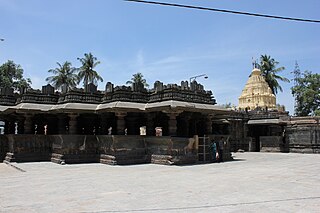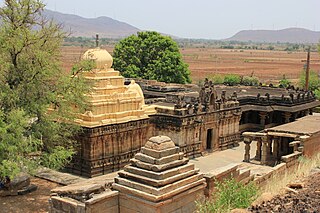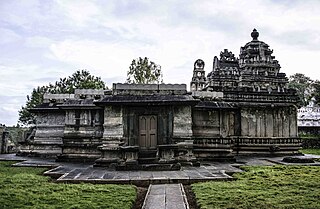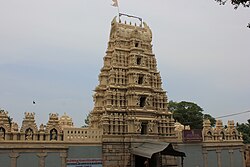
The Someshwara temple, situated in Kolar town of Karnataka state, India, built by Tamil kings Chola.is an ornate 14th century Vijayanagara era Dravidian style construction. Someshwara, another name for the Hindu god Shiva is the presiding deity in the temple. The temple is protected by the Archaeological Survey of India as a monument of national importance.

Tirumakudalu Narasipura the temple city of Karnataka, commonly known as T. Narasipura or T.N. Pura, is a town in Mysore district in the Indian state of Karnataka. The first name refers to the land at the confluence, (trimakuta in Sanskrit at the confluence of the Kaveri, Kabini and Spatika Sarovara.

The Veera Narayana temple, also referred to as the Viranarayana temple of Belavadi, is a triple Hindu temple with a complex Hoysala architecture completed around 1200 CE. Close to Halebidu, this is a better preserved large Hoysala monument found in the small village of Belavadi, Chikkamagaluru district of Karnataka, India.

The Ranganathaswamy temple, also rendered the Sri Ranganathaswamy temple, in Srirangapatna, in the Mandya district of Karnataka state, India, is dedicated to the Hindu god Ranganatha. It is one of the five important pilgrimage sites of Sri Vaishnavism along the river Kaveri for devotees of Ranganatha. These five sacred sites are together known as Pancharanga Kshetrams in South India. Since Srirangapatna is the first temple starting from upstream, the deity is known as Adi Ranga. The town of Srirangapatna, which derives its name from the temple, is located on an island in the river Kaveri.

Harihareshwara Temple is a Hindu temple situated in Harihar, Karnataka state, India. The temple was built in c. 1223–1224 CE by Polalva, a commander and minister of the Hoysala Empire King Vira Narasimha II. In 1268 CE, Soma, a commander of King Narasimha III of the same dynasty made some additions. The temple houses the deity Harihara, a fusion of the Hindu gods Vishnu and Shiva. The image of the deity is a fusion of the right vertical half of Shiva and left vertical half of Vishnu. The image holds in its right hand, the attributes of Shiva and in the left hand, those of Vishnu.

The antiquity of architecture of Karnataka can be traced to its southern Neolithic and early Iron Age, Having witnessed the architectural ideological and utilitarian transformation from shelter- ritual- religion. Here the nomenclature 'Architecture' is as old as c.2000 B.C.E. The upper or late Neolithic people in order to make their shelters, they constructed huts made of wattle and doab, that were buttressed by stone boulders, presumably having conical roof resting on the bamboo or wooden posts into red murram or paved granite chips as revealed in archaeological excavations in sites like Brhamagiri, Sanganakallu, Tekkalakota, Piklihal. Megaliths are the dominant archaeological evidence of the early Iron Age. There are more than 2000 early Iron Age burial sites on record, who laid the foundation for a high non-perishable architecture in the form of various distinct architectural styles of stone built burials, which are ritualistic in its character. The active religious architecture is evident 345 with that of the Kadamba Dynasty. Karnataka is a state in the southern part of India originally known as the State of Mysore. Over the centuries, architectural monuments within the region displayed a diversity of influences, often relaying much about the artistic trends of the rulers of twelve different dynasties. Its architecture ranges dramatically from majestic monolith, such as the Gomateshwara, to Hindu and Jain places of worship, ruins of ancient cities, mausoleums and palaces of different architectural hue. Mysore Kingdom (Wodeyar) rule has also given an architectural master structure in the St. Philomena's Church at Mysore which was completed in 1956, in addition to many Dravidian style architectural temples. Two of the monuments are listed under the UNESCO World Heritage List of 22 cultural monuments in India. Styles of Indo-Saracenic, Renaissance, Corinthian, Hindu, Indo-Greek and Indo-British style palaces were built in Mysore, the city of palaces. Sikh architecture at Bidar (1512) and also in Bangalore in 1956 can also be cited as having an impact on the architectural composition of the state.

Bucesvara temple, also referred to as the Buceswara, Bucheshwara or Bhucheshvara temple, is a 12th-century Hindu temples in Koravangala village, Karnataka, India. The most sophisticated historical temple in the village, it is considered to be the flag-bearer of Hoysala architecture and was built by a wealthy patron named Buchi during the reign of king Ballala.

The Kalleshvara temple is located in the town of Ambali in Bellary district of Karnataka state, India. According to an Old Kannada inscription placed in the sabhamantapa, the temple was constructed during the reign of the Western Chalukya Empire King Vikramaditya VI. This temple is protected as a monument of national importance by the Archaeological Survey of India.

Kalleshwara temple is located in the village of Bagali it was 9km away from Harpanahalli city in the Vijayanagara district of Karnataka state, India.

Panchalingeshwara Temple in Govindanahalli, Mandya district, Karnataka state, India, was constructed around 1238 A.D. during the reign of the Hoysala empire King Vira Someshwara. The name "Panchalingeshwara" literally means "five linga". The temple is protected as a monument of national importance by the Archaeological Survey of India. The famous sculptor of Hoysala times, Ruvari Mallitamma, is known to have made contributions to the temple.

The Rameshvara temple is a 12th-century Shiva temple in Kudli, Shimoga district, Karnataka India. It is an early non-ornate, Hoysala construction with simpler Vesara style. The village of Koodli – also spelled Kudli, Kudali – was a major town through the 14th-century and of great antiquity, with ruins of over eight major Hindu temples and monasteries. It is located about 18 kilometres (11 mi) north-east of Shimoga city, the district headquarters. The town gets its name because it is situated at the confluence of the Tunga and Bhadra tributaries that form the Tungabhadra river.

The Saumyakeshava temple at Nagamangala was constructed in the 12th century by the rulers of the Hoysala empire. Nagamangala is a town in the Mandya district of Karnataka state, India. It is located 62 km from the historically important town Mysore, on the Srirangapatna-Sira highway. Historically, Nagamangala came into prominence during the rule of Hoysala King Vishnuvardhana when it became an important center of Vaishnava faith and received patronage from one of his queens, Bommaladevi. During the rule of Veera Ballala II, Nagamangala prospered as an agrahara and had the honorific Vira Ballala Chaturvedi Bhattaratnakara. The temple is protected as a monument of national importance by the Archaeological Survey of India.

Akkana Basadi is a Jain temple (basadi) built in 1181 A.D., during the rule of Hoysala empire King Veera Ballala II. The basadi was constructed by the devout Jain lady Achiyakka, wife of Chandramouli, a Brahmin minister in the court of the Hoysala king. The main deity of the temple is the twenty-third Jain Tirthankar Parshwanath. The temple is protected as a monument of national importance by the Archaeological Survey of India. It is part of an Archaeological Survey of India Adarsh Smarak Monument along with other temples in the Shravanabelagola group of monuments.

Bhoganandiswara Temple and Arunachaleswara Temple are a twin Hindu temples complex located in Nandi village in Chikkaballapur district of Karnataka, India. Ornate, beautifully carved and dedicated to Shiva, they have been variously dated between the 9th- to 10th-century CE.

The Ranganatha Swamy and the Someshwara temples are located in the historic town of Magadi, about 41 km from Bangalore, the capital of the Indian state of Karnataka. These temples are protected monuments under the Karnataka state division of the Archaeological Survey of India.

The group of temples at the Amba Vilas Palace in Mysore were constructed during various periods by the kings of the Wodeyar dynasty who ruled the Kingdom of Mysore from about 1399 to 1947 A.D. These temples are protected monuments under the Karnataka state division of the Archaeological Survey of India.

Hale Yedatore, a village in the Krishnaraja Nagara taluk of the Mysore district, Karnataka state, India is located about four kilometers north of the commercially important newly built town of Krishnarajanagara, and about 44 km north-west of the historically important city of Mysore. The name Yedatore derives from two Kannada language words, yeda and tore – a name that arises from the "bend to the left" made by the river at that spot which is considered sacred by Hindus. There are steps leading from the temple down to the bathing areas ("ghats") by the river. Yedatore village was severely damaged in the 1920s from the flood waters of the River Kaveri, prompting the Mysore ruler to build the new town, named Krishnarajanagar, little southerly on an elevated land.

The Narasimha Swamy temple at Seebi is located in the Tumkur taluk of Tumkur district, in the Indian state of Karnataka. Seebi is located on National Highway 4, just 20 km north of Tumkur city.






















